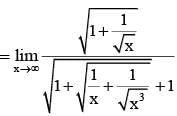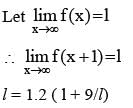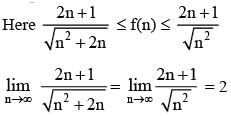Test: Limit (Competition Level) - 4 - JEE MCQ
Test Description
30 Questions MCQ Test - Test: Limit (Competition Level) - 4
Test: Limit (Competition Level) - 4 for JEE 2025 is part of JEE preparation. The Test: Limit (Competition Level) - 4 questions and answers have been prepared
according to the JEE exam syllabus.The Test: Limit (Competition Level) - 4 MCQs are made for JEE 2025 Exam.
Find important definitions, questions, notes, meanings, examples, exercises, MCQs and online tests for Test: Limit (Competition Level) - 4 below.
Solutions of Test: Limit (Competition Level) - 4 questions in English are available as part of our course for JEE & Test: Limit (Competition Level) - 4 solutions in
Hindi for JEE course.
Download more important topics, notes, lectures and mock test series for JEE Exam by signing up for free. Attempt Test: Limit (Competition Level) - 4 | 30 questions in 60 minutes | Mock test for JEE preparation | Free important questions MCQ to study for JEE Exam | Download free PDF with solutions
Detailed Solution for Test: Limit (Competition Level) - 4 - Question 2
Detailed Solution for Test: Limit (Competition Level) - 4 - Question 3
Detailed Solution for Test: Limit (Competition Level) - 4 - Question 4
Detailed Solution for Test: Limit (Competition Level) - 4 - Question 5
Detailed Solution for Test: Limit (Competition Level) - 4 - Question 6
Detailed Solution for Test: Limit (Competition Level) - 4 - Question 7
Detailed Solution for Test: Limit (Competition Level) - 4 - Question 8
Detailed Solution for Test: Limit (Competition Level) - 4 - Question 9
Test: Limit (Competition Level) - 4 - Question 10
Let f : R → R be such that f(1) = 3, f1(1) = 6 then 
Detailed Solution for Test: Limit (Competition Level) - 4 - Question 10
Detailed Solution for Test: Limit (Competition Level) - 4 - Question 11
Test: Limit (Competition Level) - 4 - Question 12
The value of  denotes greatest integer function, is
denotes greatest integer function, is
Detailed Solution for Test: Limit (Competition Level) - 4 - Question 12
Test: Limit (Competition Level) - 4 - Question 13
If a1 = 1 and an = n(1 + an–1) then the limit

Detailed Solution for Test: Limit (Competition Level) - 4 - Question 13
Test: Limit (Competition Level) - 4 - Question 14
If f(n+1) =  n∈N & f(n) > 0 for all n∈N then
n∈N & f(n) > 0 for all n∈N then f(n) is equal to
Detailed Solution for Test: Limit (Competition Level) - 4 - Question 14
Test: Limit (Competition Level) - 4 - Question 15
Let f(x) =  Then the set of values of x for which f (x) = 0 , is :
Then the set of values of x for which f (x) = 0 , is :
Detailed Solution for Test: Limit (Competition Level) - 4 - Question 15
Test: Limit (Competition Level) - 4 - Question 16
 where n is a non zero real number then a is equal to
where n is a non zero real number then a is equal to
Detailed Solution for Test: Limit (Competition Level) - 4 - Question 16
Detailed Solution for Test: Limit (Competition Level) - 4 - Question 17
Test: Limit (Competition Level) - 4 - Question 18
Let f(x) =  then
then  is equal, (where [.] denotes greatest integer function and {.} fractional part)
is equal, (where [.] denotes greatest integer function and {.} fractional part)
Detailed Solution for Test: Limit (Competition Level) - 4 - Question 18
Detailed Solution for Test: Limit (Competition Level) - 4 - Question 19
Detailed Solution for Test: Limit (Competition Level) - 4 - Question 20
Detailed Solution for Test: Limit (Competition Level) - 4 - Question 21
Test: Limit (Competition Level) - 4 - Question 22
 (where [.] denotes the greatest integer function) is equal to
(where [.] denotes the greatest integer function) is equal to
Detailed Solution for Test: Limit (Competition Level) - 4 - Question 22
Detailed Solution for Test: Limit (Competition Level) - 4 - Question 23
Detailed Solution for Test: Limit (Competition Level) - 4 - Question 24
Detailed Solution for Test: Limit (Competition Level) - 4 - Question 25
Test: Limit (Competition Level) - 4 - Question 26
If f(n+1) =  n ∈ N and f(n) > 0 for all n ∈ N then
n ∈ N and f(n) > 0 for all n ∈ N then 
Detailed Solution for Test: Limit (Competition Level) - 4 - Question 26
Detailed Solution for Test: Limit (Competition Level) - 4 - Question 27
Test: Limit (Competition Level) - 4 - Question 28
The value of  where [.] represents greatest integral function, is
where [.] represents greatest integral function, is
Detailed Solution for Test: Limit (Competition Level) - 4 - Question 28
Detailed Solution for Test: Limit (Competition Level) - 4 - Question 29
Detailed Solution for Test: Limit (Competition Level) - 4 - Question 30
Information about Test: Limit (Competition Level) - 4 Page
In this test you can find the Exam questions for Test: Limit (Competition Level) - 4 solved & explained in the simplest way possible.
Besides giving Questions and answers for Test: Limit (Competition Level) - 4, EduRev gives you an ample number of Online tests for practice
Download as PDF






 (sec x) does not exists
(sec x) does not exists










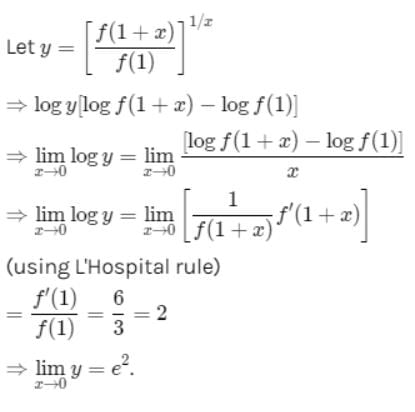
 and L=
and L= 







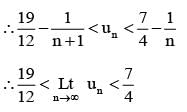



























 then m + n is equal to
then m + n is equal to 


 represents fractional part function)
represents fractional part function)






 then the constants a and b are (where a > 0)
then the constants a and b are (where a > 0) 





